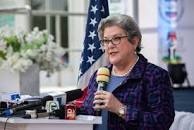HIV: US spends over $6bn for training, health workers recruitment, others
Etim Ekpimah
The United States of America has spent over $6 billion for the training and recruitment of thousands of health workers, upgrade of existing laboratories infrastructures to world-class status, develop an up-to-date data management and supply chain systems to advance the Nigeria’s government ability to deliver comprehensive HIV services.
The United States Ambassador to Nigeria, Mary Beth Leonard, remarked that it was an honour to join Nigerians to reflect upon the success of Nigeria’s HIV response over the past 35 years.
She added that when the country’s first case was reported in 1986, it marked the beginning of what appeared to be an unstoppable epidemic.
Speaking during the launch of the New Dawn publication on Tuesday, Leonard noted that the action made everybody to look back into history when an AIDS-Free generation seemed unimaginable.
This was contained in a statement issued by Aishah A. Gambari, Senior Public Affairs Specialist/Public Affairs Section, U.S Embassy to Nigeria, Abuja.
She said: “But today, we have come to celebrate that the impossible is possible and reaching HIV epidemic control is a reality for Nigeria!
“The U.S. government through the President’s Emergency Plan for AIDS Relief (PEPFAR) has improved access to HIV treatment services to every corner of this country.
“We are most proud of how we reached this point together. Our key partnerships with the national and state governments, UNAIDS, and the Global Fund were instrumental in determining what systems and strategy we needed to gain traction and outpace HIV.
“Since 2003, the United States has contributed over $6 billion to strengthen the systems side of the equation to train and recruit hundreds of thousands of health workers, upgrade existing laboratories infrastructures to world class status and develop the most up-to-date data management and supply chain systems to advance the Government of Nigeria’s ability to deliver comprehensive HIV services.
“On current targeted strategy was based on the Ministry of Health’s highly successful population-based survey, the Nigerian AIDS Indicator and Impact Survey (NAIIS).
“The data we received allowed us to zoom in on reaching 95-95-95 goals as it informed our ART Surge strategy to target treatment for populations of unknown HIV status and enlist governors and religious and traditional leaders for state-level buy-in.”
She added that the result of the achievement and journey with the Nigeria Government was what they celebrated that day in the publication led by the UNAIDS country team.
“This publication recognizes the decisions that we have made together as individuals, institutions and bilateral partners, and salutes a few of the special individuals that have helped us to achieve this great success. We are proud of what we have done together, systematically, and strategically,” Leonard added.
She stated that the U.S. Government is proud to have collaborated with the Joint UN team and other stakeholders in documenting Nigeria’s journey thus far and we look forward to continued success on our path to an AIDS-free generation.




























Post Comment